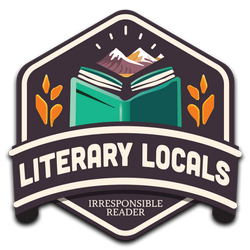 Pictures by J.R.R. Tolkien
Pictures by J.R.R. Tolkien
DETAILS: Publisher: William Morrow & Company Publication Date: November 16, 2021 Format: Hardcover Length: 104 pgs. Read Date: September 21, 2024

Why this Book Today?
Last Spring, I read Lashaan Balasingam talk about this book at Roars and Echoes and put it on a wish list instantly. I was given a copy of it last year, but aside from glancing through it then, I hadn’t taken the time to really sit down with it. But with Hobbit Day yesterday, I made time Saturday to do just that—so I could post about it today (and maybe add this and some other things to a recurring thing like I do with Towel Day).
You should really see what Lashaan had to say about it, not only does he do a (typically) better job of it than I’m about to, but he liked it a lot more than I did.
What’s Pictures by J.R.R. Tolkien About?
Well, it’s pictures drawn by Tolkein in his spare time—when he wasn’t teaching, creating new languages, writing epic fantasies, or smoking his pipe (well, he probably did both of those at the same time).
The Publisher describes it this way:
With Christopher Tolkien as your guide, take a tour through this colorful gallery of enchanting art by J.R.R. Tolkien, as published originally in the first groundbreaking Tolkien Calendars of the 1970s.
This collection of pictures, with a text by Christopher Tolkien, now reissued after almost thirty years, confirms J.R.R. Tolkien’s considerable talent as an artist. It provides fascinating insight into his visual conception of many of the places and events familiar to readers of The Hobbit, The Lord of the Rings, and The Silmarillion.
Examples of his art range from delicate watercolors depicting Rivendell, the Forest of Lothlorien, Smaug, and Old Man Willow, to drawings and sketches of Moria Gate and Minas Tirith. Together they form a comprehensive collection of Tolkien’s own illustrations for his most popular books.
Also included are many of his beautiful designs showing patterns of flowers and trees, friezes, tapestries, and heraldic devices associated with the world of Middle-earth. In their variety and scope, they provide abundant visual evidence of the richness of his imagination.
This enchanting gallery was personally selected by Christopher Tolkien who, through detailed notes on the sources for each picture, provides unique insight into the artistic vision of his father, J.R.R. Tolkien.
How’s the Writing?
Well, it’s pretty bland. It’s just straightforward descriptions of the pictures, where it came from, where it was originally published—who added color (sometimes), and so on.
It’s not bad, it’s not good—it’s just there. And that’s good enough, this isn’t supposed to be about Christopher Tolkien’s wordsmithery—this is about the pictures.
How’s the Art?
Well, I think it’s clear why we think of Tolkien as a writer, scholar, and storyteller and not a visual artist. Don’t get me wrong—I can’t hold a candle to his drawing. But it’s nothing stellar.
But it does deliver the flavor of Middle Earth and its denizens in a way the books can’t quite manage (or does manage, in a different way). You get a real sense of the scope and scale of the world. It’s clear that Jackson and his team spent some time with Tolkien’s art and drew a lot from it—and you can see why they’d want to (beyond just trying for authenticity). I did like it—and could easily spend time studying the details.
Lashaan’s post has a couple of samples if you’re curious. But honestly, if you’re basing getting your hands on this book on the quality of the art, you might be missing the point. (still, check out the samples to get a feel for it)
If you want great fantasy art, may I suggest starting with Larry Elmore, Chris McGrath, or Isabeau Backhaus? But there’s something about seeing it from the hand of the creator, you know?
So, what did I think about Pictures by J.R.R. Tolkien?
As a book, it’s…fine. As a collection of pictures, it’s…nice enough. As a way to get to know a different side of Tolkein and how his brain, his creativity, and his personality worked? It’s pretty cool. I’d love to see sketches, drawings, and even paintings by other authors to get inside their heads (okay, no one wants inside Thomas Harris’ mind, but you know what I’m saying. Keep the visuals for Hannibal and the rest locked away.)
Am I glad that I own this? Yes. Am I glad that I finally got around to taking it out of its slipcase and really worked through it? You bet. Am I just a little underwhelmed by the whole thing? Yup.
But I will return to flip through it and pour over the contents repeatedly.

This post contains an affiliate link. If you purchase from it, I will get a small commission at no additional cost to you. As always, the opinions expressed are my own.
![]()













